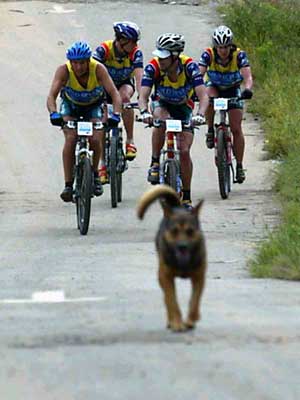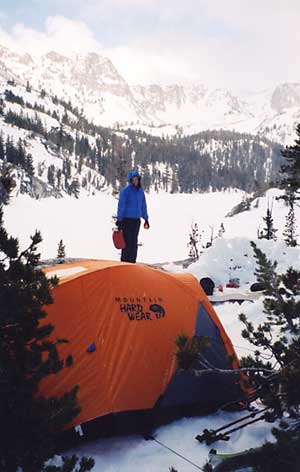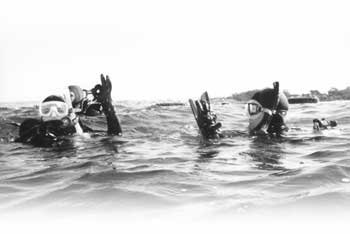In creating the Sierra Camino, Chris McNamara sees both the forest and the trees and a singletrack through them
Stringy, inflexible sagebrush grabbed at the cranks of my mountain bike while getting gummed up in the rear derailleur, forcing me to stop every hundred feet so my chain didn’t end up going rogue, destroying my rear wheel. The wild rose thorns scratched at my shins as I barely maintained forward momentum. Gopher holes were peppered about, guaranteed to either swallow my foot and ankle whole or suck my front wheel into a rodent abyss. Chris McNamara was up ahead, just barely far enough away that he couldn’t hear my expletive-laced mutterings leading the way through a sea of sagebrush.
“Where the hell are we even going?” I pondered out loud after enduring a half hour of exploration. There was no trail. There wasn’t even a hint of one. I picked up my bike and just started walking, as I was making more progress with the bike on my shoulder than with its wheels on the ground, so long as I didn’t sink my foot into a gopher hole. This was a classic “Bushwhacknamara” — the term McNamara’s wife Tor uses every time she’s goaded into a brush fiesta disguised as a mountain bike ride or a hike.
To be honest, I didn’t blame McNamara. It’s a classic strategy I’ve used more than a few times in the past on my signature gnarmega mountain bike rides. Stay just far enough ahead of your unwitting ride mates so that no matter how discouraged, angry or demoralized they are, they have to keep following you because they have no idea where they are and turning around is not an option.

To McNamara, this was just another weekend adventure. Armed with a hand saw in a plastic sheath hanging from his khaki pants belt on his right side, a small pair of loppers in another holster on his left side, a hoodie pulled over his head with a sun hat over that and a bike helmet over both, zinc-oxide sunscreen slathered all over his face and a battery-powered hedge trimmer on his back, McNamara fancies his wardrobe a distinct “dad dork” look. But to me McNamara looks like a mix between a super-hardcore arborist and a backcountry special ops commando.
Ever since McNamara got bitten by the trails bug about a decade ago, he’s been obsessed with figuring out ways to connect one place to the next with trail. To borrow terminology from his past as a legendary climber, McNamara is in search of first ascents on trails, connecting places that have never been connected by trail before. And his main pet project is the Sierra Camino; a multi-use trail open to wheeled traffic ultimately connecting Susanville on the northern end of the Sierra Nevada with Lone Pine on the southern end.
The Sierra Camino is a smaller component of the grand vision, the Orogenesis Trail; a mountain-bike legal alternative to the Pacific Crest Trail, enabling mountain bikers to ride from Canada to Mexico on trails. But unlike the PCT, Orogenesis also includes the Baja Divide, a route running from the American border south to the tip of Baja. It’s an ambitious, 4,000+ mile project dreamed up by its founder, Gabe Tiller, the man who also dreamed up the Oregon Timber Trail, a 670-mile route through Oregon on a series of singletracks and dirt two-tracks. McNamara is a huge fan of Orogenesis, to the point that he led a $200,000 fundraising campaign so Orogenesis Collective could become a 501c3 non-profit and hire Tiller as its Executive Director.

McNamara and Tiller met when Tiller was searching for regional resources to help figure out what roads and trails already existed, the proverbial low hanging fruit of the trails world. McNamara immediately signed up as a scout in the Lake Tahoe region as he was already dialing in a route so he could ride from his home in South Lake Tahoe to Mammoth. The challenge blossomed into a full obsession for McNamara, leading him down the path of scouring maps day and night, discovering LiDAR technology to find old roadbeds and getting out in the field as much as possible to put the puzzle pieces into place.
Charity Valley Trail
In the course of this exploration, McNamara uncovered a couple of gems. One of them is called Charity Valley. Connecting the Blue Lakes area near Hope Valley with the hamlet of Markleeville, Charity Valley Trail runs approximately seven miles from Blue Lakes Road down to Grover Hot Springs just west of Markleeville. Charity Valley is very rich in history, and for a long time it was seldom used by only a few hikers. The trail was used by Kit Carson and John C. Fremont in 1844 to cross the Sierra Nevada. But to make it extra interesting, in classic Carson and Fremont fashion, they did it in a February blizzard and were almost forced to eat one of their horses to survive.
Charity Valley is anything but a casual cruise on a mountain bike. The 2,000 vertical feet of descent to Markleeville is raw, rugged and radical, filled with huge granite slabs, stair-stepped rocks and bouldery chunder, finishing with a loose, surfy and sandy couple miles to Grover Hot Springs State Park. The recent Tamarack fire that almost burned Markleeville to the ground devastated the lower couple miles of Charity Valley, mixing the ash with the sandy soil, making for some uniquely black clouds of dust when riding. If you have an appetite for technical trail, Charity Valley is a feast you must sample.
Charity Valley also happens to be the perfect addition to Sierra Camino and Orogenesis, because it connects Hope Valley to Markleeville, providing an ideal route for travelers between Lake Tahoe and the route to Mammoth. It also happens to be an ideal shuttle, considering you can drive from Markleeville to Blue Lakes Road in less than 30 minutes. When I first rode Charity Valley last summer with McNamara, finishing at the Cutthroat Tavern for a burger and beer, I realized Charity Valley could become Alpine County’s version of the Downieville Downhill, especially once a trail is connected from Carson Pass to Charity Valley, extending the ride into a 15-mile, 3,800 vertical foot descent.
I was one of the first to experience a classic McNamara mountain bike first descent. In five years from now, with a little more trail maintenance and dialing in of Charity Valley, I could see this becoming one of the most popular mountain bike shuttles in the region. But late last summer, Cutthroat closed its doors, leaving a huge void in the recipe of a classic mountain bike ride. As good as Charity Valley is, you have to have a great place of grub and grog at the finish.
McNamara recognized the threat to his Charity Valley discovery and rallied a group of investor friends to purchase the Cutthroat Tavern business and the building, the oldest building in Alpine County, built in 1862. Under new ownership, the Cutthroat is reopened for business, a must-stop at the end of a Charity Valley experience.

The Lost Cannon Loop
Another gem McNamara unearthed is the Lost Cannon loop, a 14-mile route with 2,500 feet of climbing and descending up against the mighty Eastern Sierra Nevada near the town of Walker. The mostly singletrack loop is visually stunning, and follows another fabled Carson and Fremont route where they somehow lost track of a cannon they were transporting, leading to the legend of the Lost Cannon. However, at last year’s Nevada Day Parade in Carson City, I visited the Nevada State Museum where an old cannon sat in the front lobby, the alleged lost cannon that is apparently no longer lost.
Riding in a counter-clockwise direction, the route ascends Lost Cannon Canyon in the shadow of the 11,000-foot Lost Cannon Peak. The trail is rich in massive granite boulders, towering evergreens and numerous aspen groves along Lost Cannon Creek, peaking out in the lush and wildflower-filled Summit Meadows at 9,000 feet elevation, before a fun, fast and flowing descent down Mill Creek Canyon alongside girthy juniper trees, completing the loop. The Lost Cannon Canyon segment is another essential component to the Sierra Camino route thanks to the many days McNamara spent in search of it, an instant classic backcountry mountain bike ride with Walker Burger only a 20-minute drive back down Mill Canyon for post-ride refueling.

The Charity Valley and Lost Cannon rides are prime examples of the efforts McNamara has put into finding the low-hanging fruit of old trails. Despite his obligations of being a father and husband as well as being a part-owner of the online product review site GearLab, McNamara finds time even if it means waking up at 4am to drive an hour south, hike for two hours, then an hour back to be at work by 8pm. When it comes to McNamara and trails, there is both a will and a way.
After an hour of Bushwhacknamara through the sagebrush and wild rose, we finally reached a long-running bluff overlooking the expansive Slinkard Valley south of Monitor Pass. The view was remarkable, most definitely worth the sagebrush slog. McNamara pointed out the direction he’d like to see the Sierra Camino go, and as much as I was cursing his name while fighting through the brush, I knew there was a method to McNamara’s bushwhack madness. McNamara is a visionary, constantly imagining where the Sierra Camino might fit within the landscape, no matter how tall or thick the brush may be.




















